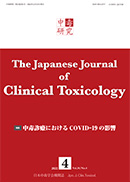Volume 35, Issue 4
Displaying 1-4 of 4 articles from this issue
- |<
- <
- 1
- >
- >|
Case Reports
-
Article type: Case Reports
2022 Volume 35 Issue 4 Pages 307-312
Published: December 10, 2022
Released on J-STAGE: January 26, 2023
Download PDF (1192K) -
Article type: Case Reports
2022 Volume 35 Issue 4 Pages 313-318
Published: December 10, 2022
Released on J-STAGE: January 26, 2023
Download PDF (927K) -
Article type: Case Reports
2022 Volume 35 Issue 4 Pages 319-324
Published: December 10, 2022
Released on J-STAGE: January 26, 2023
Download PDF (991K)
Brief Case Report
-
Article type: Brief Case Report
2022 Volume 35 Issue 4 Pages 325-328
Published: December 10, 2022
Released on J-STAGE: January 26, 2023
Download PDF (825K)
- |<
- <
- 1
- >
- >|
